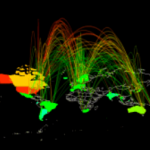Human Networking Theory Explains Infectious Disease Spread
Posted on December 16, 2010 by Jeffrey Newman
 New studies using human networking theory gives a clearer idea of how infectious diseases such as the common cold, influenza, whooping cough and SARS are spread through a closed group and also through large populations. The results are published in this week’s Journal Proceedings of The National Academy of Sciences. Volunteers in a school were asked to spend one school day wearing matchbox sized sensor devices called motes around their next. Each was tracked and the interactions analyzed.The information is expected to help with public health initiatives like vaccinations and prevention education.
New studies using human networking theory gives a clearer idea of how infectious diseases such as the common cold, influenza, whooping cough and SARS are spread through a closed group and also through large populations. The results are published in this week’s Journal Proceedings of The National Academy of Sciences. Volunteers in a school were asked to spend one school day wearing matchbox sized sensor devices called motes around their next. Each was tracked and the interactions analyzed.The information is expected to help with public health initiatives like vaccinations and prevention education.
